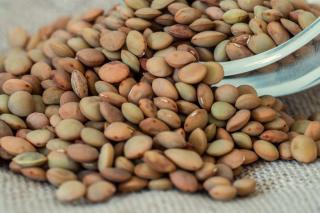

Lentil is a very significant food. It has been grown since the dawn of civilization for its seeds. They’re full of health benefits and nutrients, especially protein.
Read also:
You’ve certainly used it in salads this summer, and lentil can be a great side for your meals this fall and winter. Rich in fiber, 1/8th oz (4 g) for 3.5 oz (100 g) which is about 15% of the daily recommended intake, lentil is very easily absorbed and promotes good digestion. Also rich in complex sugars, lentil is an interesting source of energy that diffuses slowly. Its elevated fiber content also makes it an ideal ally for lazy intestines.
 Another asset of lentil is its plant protein content, which is of high quality. Thus, persons who eat no or only few animal proteins can combine the legume family with grain products or nuts, which allows them to beef up on the complete roster of protein to contain all essential amino acids.
Another asset of lentil is its plant protein content, which is of high quality. Thus, persons who eat no or only few animal proteins can combine the legume family with grain products or nuts, which allows them to beef up on the complete roster of protein to contain all essential amino acids.
Vitamin B and magnesium intake is also significant, respectively 32 mg per 3.5 oz (100 g) and 9% of daily needs. This is an asset to ensure proper heart rate and spruce up the immune system.
Any disadvantage? Lentil is sometimes a bit difficult to digest for some persons.
In cooking, lentils have the advantage of requiring less cooking time than most legumes. Green or brown lentils are more common and are used in soup, but a smaller, coral-colored lentil (sometimes called red lentil) also exists.
Lentils don’t need to be soaked prior to cooking. Rinse them quickly in cold water and place them in a pan with about 3 times their volume in cold water, without salt. Bring to boil and cover, let cook for 20 to 25 minutes. Taste, drip-dry.
They are delicious with all types of meat (veal, pork, sausage, ham, bacon). Try out preparing them as a mixed salad, with shallots, bacon bits and spicy salad dressing, or blend them to make cream soup.